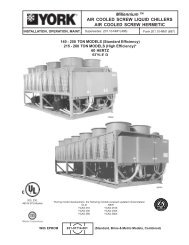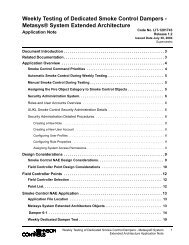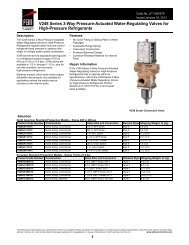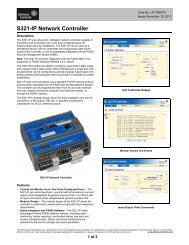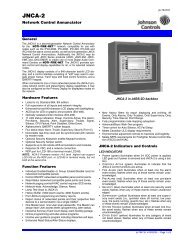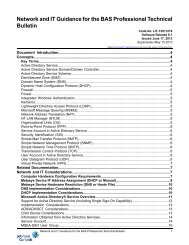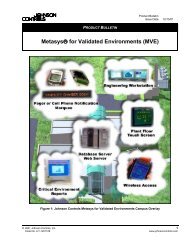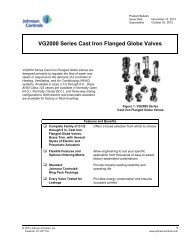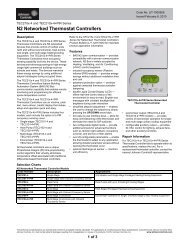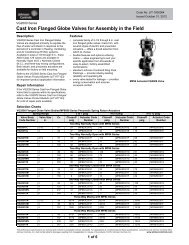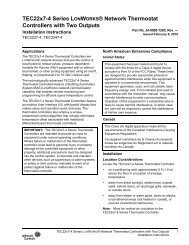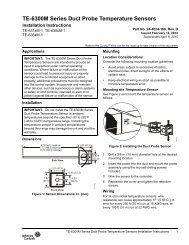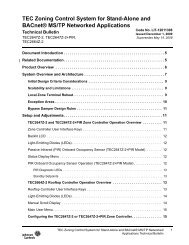YVAA Style A Air-Cooled Screw Liquid Chillers ... - Johnson Controls
YVAA Style A Air-Cooled Screw Liquid Chillers ... - Johnson Controls
YVAA Style A Air-Cooled Screw Liquid Chillers ... - Johnson Controls
Create successful ePaper yourself
Turn your PDF publications into a flip-book with our unique Google optimized e-Paper software.
FORM 201.28-NM1.1<br />
ISSUE DATE: 8/29/2012<br />
Start/Stop Schedule<br />
Program the daily and holiday start/stop by pressing<br />
the SCHEDULE key (see SECTION 8 - MICROPANEL<br />
Date/Time and Schedule Keys on Page 120).<br />
Setpoint and Remote Offset<br />
Set the required leaving chilled liquid temperature<br />
setpoint and Control Range under the SETPOINTS key.<br />
The chilled liquid temperature control settings need to<br />
be set according to the required operating conditions.<br />
If remote temperature reset (offset) is to be used,<br />
the maximum reset required must be programmed<br />
by pressing the SETPOINTS key (see SECTION 8 -<br />
MICROPANEL Setpoints Key on Page 112).<br />
FIRST TIME START UP<br />
Interlocks<br />
During the commissioning period there<br />
should be sufficient heat load to run the<br />
unit under stable full load operation to<br />
enable the unit controls, and system operation<br />
to be set up correctly, and a commissioning<br />
log taken.<br />
Verify that liquid is flowing through the evaporator<br />
and that heat load is present. Ensure that any remote<br />
run interlocks are in the run position and that the Daily<br />
Schedule requires the unit to run or is overridden.<br />
Unit Switch<br />
Place the UNIT switch on the keypad to the ON position.<br />
Startup<br />
Press the SYSTEM SWITCHES key and place the<br />
system switch for System 1 to the ON position. There<br />
may be a few seconds delay before the first compressor<br />
starts because of the anti-recycle timer). Be ready<br />
when each compressor starts, to switch the UNIT<br />
switch OFF immediately, if any unusual noises or other<br />
adverse conditions develop.<br />
When a compressor is running, the controller monitors<br />
oil pressure, motor current, and various other system<br />
parameters such as discharge pressure, chilled liquid<br />
temperature, etc. Should any problems occur; the control<br />
system will immediately take appropriate action<br />
and display the nature of the fault.<br />
Oil Pressure<br />
SECTION 6 - COMMISSIONING<br />
When a compressor starts, press the relevant “System<br />
Pressures” key and verify that oil differential pressure<br />
(oil pressure-suction pressure) develops immediately.<br />
If oil pressure does not develop, the automatic controls<br />
will shut down the compressor. Under no circumstances<br />
should a restart attempt be made on a compressor,<br />
which does not develop oil pressure immediately.<br />
Switch the UNIT switch to the OFF position.<br />
Loading<br />
Once the unit has been started, all operations are fully<br />
automatic. After an initial period at minimum capacity,<br />
the control system will adjust the unit load depending<br />
on the chilled liquid temperature and rate of temperature<br />
change. If a high heat load is present, the controller<br />
will increase the speed of the compressor(s).<br />
Condenser and Fan Rotation<br />
Once a compressor is running, discharge pressure rises<br />
as refrigerant is pumped into the air-cooled condenser<br />
coils. This pressure is controlled by stages of fans to<br />
ensure maximum unit efficiency while maintaining<br />
sufficient pressure for correct operation of the condensers<br />
and the lubrication system.<br />
As discharge pressure rises, the condenser fans operate<br />
in stages or ramp up in speed to control the pressure.<br />
Verify that the fans operate in the correct direction of<br />
rotation and operation is correct for the type of unit.<br />
System Charge<br />
Check system charge at steady full compressor load<br />
only. It is important that all fans are running for the<br />
system. The refrigerant level in the evaporator should<br />
be about in the middle of the sight glass. Unless levels<br />
are at the bottom or the top of the sight glass, they<br />
should not cause concern or require adding or removing<br />
charge.<br />
General Operation<br />
After completion of the above checks for System 1,<br />
switch OFF the SYS 1 switch on the keypad and repeat<br />
the process for each subsequent system. When all run<br />
correctly, stop the unit, switch all applicable switches<br />
to the ‘ON’ position and restart the unit.<br />
Assure all checks are completed in the Equipment Pre -<br />
Startup and Startup Checklist. The chiller is then ready<br />
to be placed into operation.<br />
JOHNSON CONTROLS 83<br />
6



